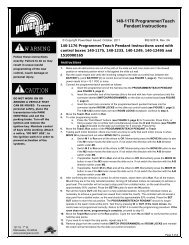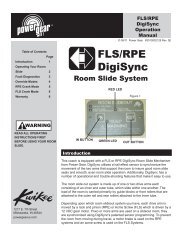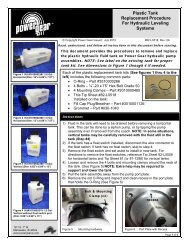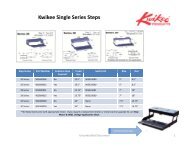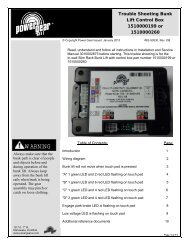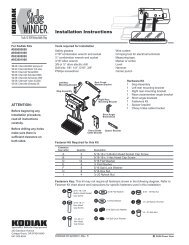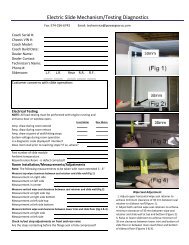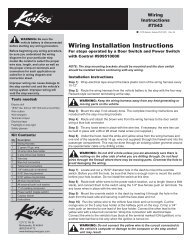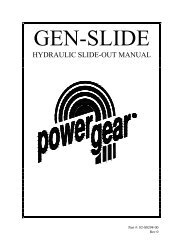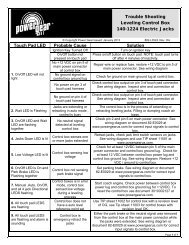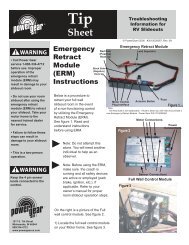Create successful ePaper yourself
Turn your PDF publications into a flip-book with our unique Google optimized e-Paper software.
GENERALSERVICE NOTESThese general servicenotes and the <strong>Step</strong>Test Proceduresaddress the mostcommon questionsabout Kwikee electricsteps. Due to thenumber of variableconditions, you mayexperience symptomsother than thosecovered. Please feelfree to contact theCustomer ServiceDepartment at1-800-736-9961 forfurther information orassistance.If the power wire to the step is disconnected from its source and reconnected, a spark iscommon. This is caused by the momentary charging of the control unit and does notnecessarily indicate the system is staying on, which would cause a drain on the battery. Ifbattery drain is suspected, observe the understep light (if so equipped) while the step isextending. The override switch must be 'off' for the understep light to operate.To determine if a control unit is not shutting off, remove the four-way connector to thechassis and the two-way connector between the step motor and the contol unit. Place avoltmeter between the red and yellow motor wires at the two-way connector from thecontrol unit. Reconnect the four-way Connector. Turn the override switch 'on.' If anyvoltage registers on the meter for more than 5 seconds, the control unit is not shutting offand may be defective. When doing this test, switch the voltmeter leads back and forthbetween the red and yellow motor wires to be sure no voltage registers.If any voltage does register, disconnect the four-way connector to keep the step motor fromoverheating. If zero voltage is present, the control unit has shut off and is normal.If the step does not work or operates erratically, such as extending part way and shutting'off,' the first item that should be checked is the vehicle’s battery. Low supply voltage maycause erratic operation of the step. Poor ground connections may also cause erraticoperation of the step. Check battery voltage and condition. A battery in good condition andproperly charged will have a no load voltage of approx. 12.6 volts. Check the voltage at thebattery and at the four-way connector at the control unit. Insure that all battery and stepcontrol unit connections are clean and secure. Recharge or replace the battery as necessaryand retest the step for proper operation.The step may also operate erratically if the step is being operated directly from a converter,and the output from the converter is not adequate or properly filtered for clean DC voltage.The converter must be capable of producing a minimum of 30 amps for proper stepoperation.If the ground to the control unit is lost, either between the step control unit and the vehiclechassis (the long green ground wire) or between the vehicle battery and the ground(negative battery cable) the step will not function. Make sure the battery terminals and allwire connections are clean and tight. Verify that all wires meet the minimum requirementsspecified in Figures 4 and 5 on Page 8.TROUBLESHOOTINGAND TESTINGPROCEDURESThe following <strong>Step</strong> Test Procedures have been provided to troubleshoot and test all of theKwikee automatic electric step functions. They are designed to initially check the step'sbasic functions separately from the RV wiring to determine whether or not the step ismalfunctioning. The following procedures test the various components of the step until thesource of the malfunction is located. Using these procedures will shorten and reduce thetime spent troubleshooting.Some portions of the test procedures require additional equipment. This equipmentincludes: a voltmeter, a well charged 12 volt DC automotive battery, and a 4-wayconnector/pigtail (Part #909306000, available from Kwikee Products Company).Read the entire procedure prior to testing. If you need assistance contact Kwikee’sService Line at 1-800-736-9961.Page 6 / MaintenanceKwikee <strong>42</strong> <strong>Series</strong> <strong>Step</strong>



